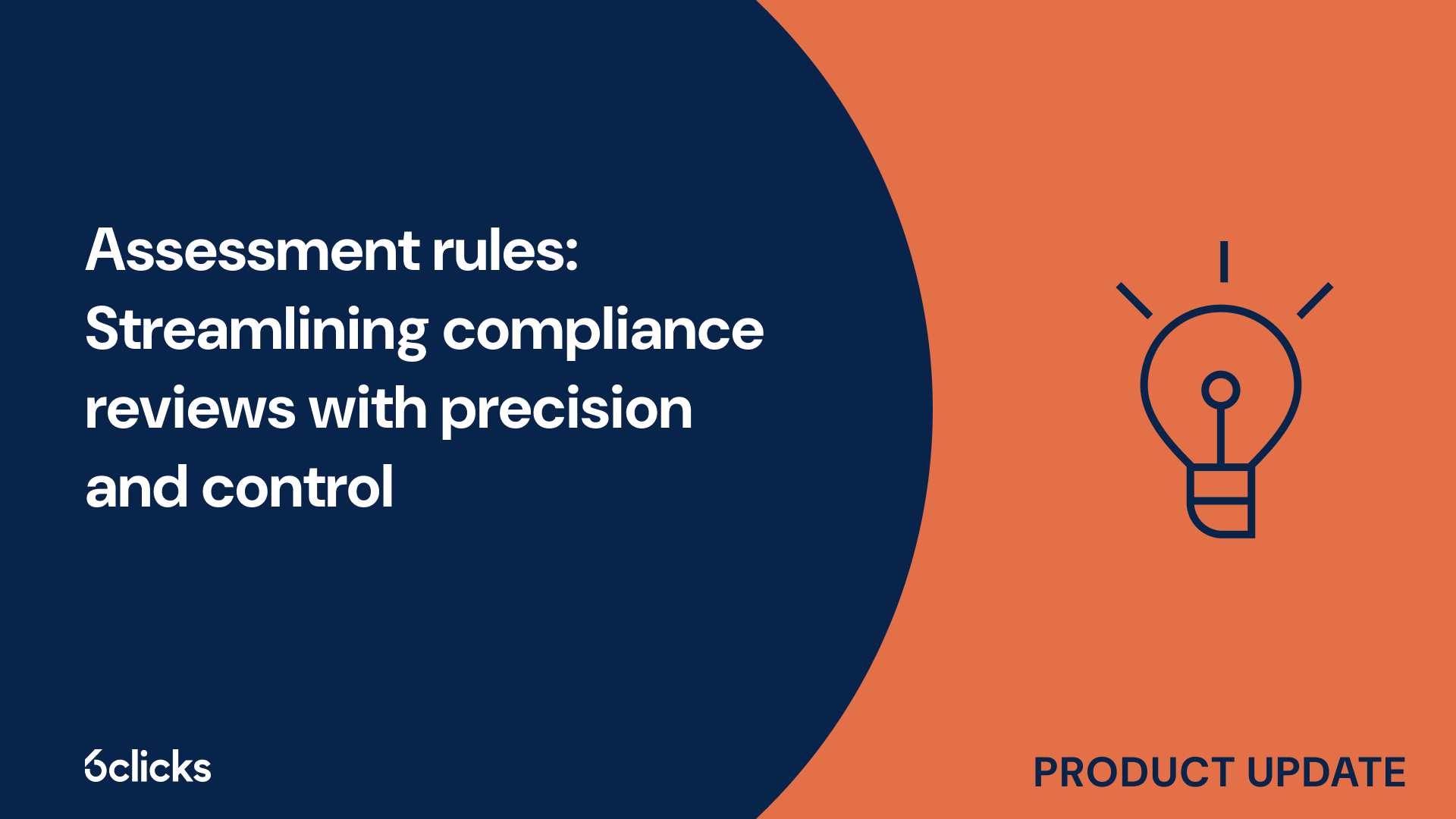The GRC buyer’s guide for 2025: Building resilience with AI-powered, federated solutions
Discover the ultimate GRC buyer's guide for 2025! Uncover how AI-powered, federated solutions transform compliance and security management for industries like government, aerospace, banking, and more. Learn about centralized control, continuous compliance, and advanced cyber GRC capabilities. Download now!
-1.png?width=200&height=249&name=Group%20193%20(1)-1.png)
The GRC buyer’s guide for 2025: Building resilience with AI-powered, federated solutions
What is security clearance?
Security clearance is a crucial component of maintaining national security, particularly in countries like Australia. It refers to the process through which individuals are granted authorized access to classified information. The main objective of security clearance is to ensure that individuals with access to sensitive materials and information are trustworthy, reliable, and pose no threat to national security. The Australian government has established a comprehensive security vetting process to determine the highest level of security clearance an individual can obtain. This process involves background checks, including criminal and financial history, as well as assessing the individual's loyalty, integrity, and suitability for accessing classified materials. By adhering to a stringent vetting process, the Australian government aims to protect the country's national security interests and prevent unauthorized disclosure of sensitive information. It is essential for government agencies and personnel who handle classified materials to undergo this vetting process and maintain the highest standards of security protocols.
What is the highest security clearance in australia?
The highest security clearance in Australia is known as Positive Vetting (PV). PV is a comprehensive and rigorous background check process that grants individuals with the highest level of access to security classified information.
To obtain PV, individuals must undergo an extensive vetting process conducted by the Australian Government Security Vetting Agency (AGSVA). This process includes thorough background investigations, including criminal and financial history checks, as well as assessments of personal conduct and associations.
PV clearance holders are granted ongoing access to highly sensitive and secret material. They have the ability to handle, work with and access intelligence and security information that is critical to national security.
It's important to note that the granting of PV clearance is subject to procedural fairness and multiple levels of scrutiny to ensure the utmost trustworthiness and reliability of the individuals entrusted with this information.
Overview of the process
To obtain the highest security clearance in Australia, known as Positive Vetting (PV), individuals must undergo an extensive vetting process conducted by the Australian Government Security Vetting Agency (AGSVA). This process includes comprehensive background investigations, such as criminal and financial history checks, as well as assessments of personal conduct and associations. Those who are granted PV clearance have ongoing access to highly sensitive and secret material, allowing them to handle, work with, and access intelligence and security information critical to national security. The granting of PV clearance is carefully overseen to ensure procedural fairness and multiple levels of scrutiny to guarantee the utmost trustworthiness and reliability of those entrusted with this information.
The application process
The application process for obtaining a security clearance in Australia involves a thorough vetting and verification procedure. Applicants undergo various checks to ensure their suitability for access to classified information.
The process includes mandatory background checks, which involve verification of identity, financial probity checks, police records checks, and referee checks. Qualification verification is also conducted to ensure the applicant's qualifications are legitimate. A thorough digital footprint check is carried out to assess the applicant's online presence.
Additionally, applicants undergo a psychological assessment to evaluate their mental fitness for accessing classified information. A security interview is conducted to assess the candidate's suitability, trustworthiness, and loyalty to the Australian government.
The application process aims to ensure that individuals granted security clearances are trustworthy and have no history of activities that may compromise national security. It is a comprehensive and meticulous process designed to protect sensitive and classified information.
Requirements for secure clearances
Requirements for secure clearances in Australia are stringent to ensure the highest level of national security. Individuals seeking a security clearance must undergo thorough background investigations, including checks on their criminal and financial history. These investigations are aimed at identifying any potential risks or vulnerabilities that could compromise the security of classified information.
Procedural fairness is a key aspect of the clearance process, ensuring that individuals are treated fairly and equitably throughout the vetting process. This includes adherence to established protocols and guidelines, as well as providing the opportunity for candidates to present any relevant information to support their application.
Background investigations are conducted to verify the applicant's identity, qualifications, and employment history. Extensive criminal history checks are carried out to ensure that individuals with a history of criminal activity are not granted access to sensitive information.
Financial history checks are also conducted to assess an individual's financial stability and identify any potential vulnerabilities to exploitation or compromise.
The rigorous requirements for secure clearances in Australia help in maintaining the trust and integrity of government agencies and ensure the protection of national security interests. Adherence to these requirements is essential for individuals who wish to work in roles requiring access to classified information.
The vetting process
The vetting process for granting a security clearance in Australia involves a thorough and comprehensive assessment of an individual's background to ensure they are suitable for accessing classified information. This process includes various checks and assessments to verify the applicant's identity, background, educational qualifications, criminal history, financial stability, and personal references.
Identity checks are conducted to confirm the applicant's identity and ensure they are who they claim to be. This helps in preventing identity fraud and ensures that sensitive information is accessed by authorized individuals only.
Background checks focus on reviewing the applicant's personal and professional history, including employment records, education qualifications, and any affiliations with potentially sensitive organizations or individuals. These checks help in assessing the individual's trustworthiness and loyalty to the Australian government.
Police checks are essential to identify any criminal history, including offenses that may jeopardize national security or indicate a potential risk for compromise. Financial checks are carried out to evaluate an individual's financial stability and assess any vulnerabilities that could be exploited.
Referee checks involve contacting individuals listed by the applicant as references to gather information about their character, integrity, and suitability for a security clearance. This provides additional insight into the individual's reliability and trustworthiness.
Psychological testing may also be conducted to evaluate an applicant's mental and emotional stability, ensuring they can handle the demands and pressures that come with accessing classified information.
It is crucial for applicants to disclose all relevant information, cooperate in providing the necessary personal documentation, and provide accurate information throughout the vetting process. Any attempts to hide or falsify information can lead to disqualification from obtaining a security clearance.
Procedures for granting a security clearance
The procedures for granting a security clearance in Australia involve a thorough vetting process and background checks. Applicants must meet certain requirements and criteria to be considered for clearance.
The security clearance process begins with identity checks to confirm the applicant's identity and prevent fraud. Background checks are then conducted to review the applicant's personal and professional history, including employment records, education qualifications, and affiliations with potentially sensitive organizations or individuals.
Police checks are essential to identify any criminal history that could pose a risk to national security. Financial checks are also carried out to assess an individual's financial stability and identify any vulnerabilities that could be exploited. Additionally, referee checks involve contacting provided references to gather information about the applicant's character, integrity, and suitability for a security clearance.
The vetting process may also include psychological testing to evaluate an applicant's mental and emotional stability. It is crucial for applicants to disclose all relevant information and cooperate throughout the process. Any attempts to hide or falsify information can result in disqualification from obtaining a security clearance.
Australian government security vetting agencies
In Australia, the responsibility for conducting security vetting and clearance processes lies with various government agencies. These agencies are tasked with ensuring the integrity and protection of Australia's national security by thoroughly screening individuals who seek access to classified information or sensitive government positions. The processes include comprehensive background checks, including identity verification, criminal history checks, financial assessments, and psychological evaluations. This article will explore the Australian government security vetting agencies and the important role they play in safeguarding the nation's security.
The department of defence
The Department of Defence plays a vital role in the security clearance process in Australia. As the principal agency responsible for the nation's defense and security, it collaborates closely with the Australian Government Security Vetting Agency (AGSVA) to ensure that only individuals with the highest level of integrity and trustworthiness have access to sensitive information.
The AGSVA, established under the Department of Defence, is responsible for conducting background investigations and granting security clearances to individuals working in government agencies. However, the agency has faced various challenges over the years, including delays in processing clearances and a lack of compliance with government security policy.
To address these challenges, the AGSVA has undergone significant improvements in recent years. It has implemented measures to enhance its service delivery, including streamlining and digitizing processes to reduce processing times. Additionally, the agency has strengthened its compliance with government security policy, ensuring that the vetting process is robust and thorough.
The Department of Defence, in collaboration with the AGSVA, remains committed to safeguarding national security by conducting comprehensive background checks and granting security clearances to individuals with the highest level of trust and reliability. Through its ongoing efforts, the department continues to optimize the security clearance process and maintain the integrity of classified information within the Australian government.







